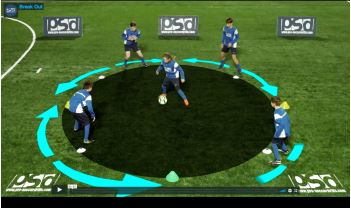Basics of the 4-2-3-1 Formation
Setup
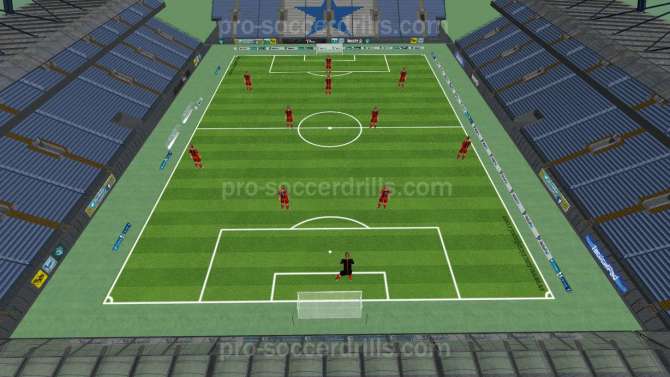
The original 4-2-3-1 formation consists of 4 defenders (2 centre backs and 2 full-backs), 2 defensive (holding) midfielders, 3 attacking (creative) midfielders and 1 striker. This system of play is one of the most popular systems used in soccer. The back four gives the width for the team either in or out of possession, the two holding midfielders cover the space in the front of the centre backs and creative midfielders have enough cover behind their back to show their individual skills with the ball.
The back four
The four defenders in the 4-2-3-1 system work as a flat back four so they use the defensive mechanism developed by Arrigo Sacchi.
The centre backs are protected in defence so they have enough time and space to mark the opponent's striker.
The two full backs have enough space to help the attacks on the flanks by overlapping the two wide midfielders. This may create 2v1 situations on the flank and may be used to get behind the opposition's defence. Full backs can safely run high on the pitch as the centre backs are still protected by two defensive midfielders.
Coaches should choose full backs who have high lactate threshold (LT) rate and able to make long sprints many times. These full backs should also be good at 2:1 situations and timing the overlaps.
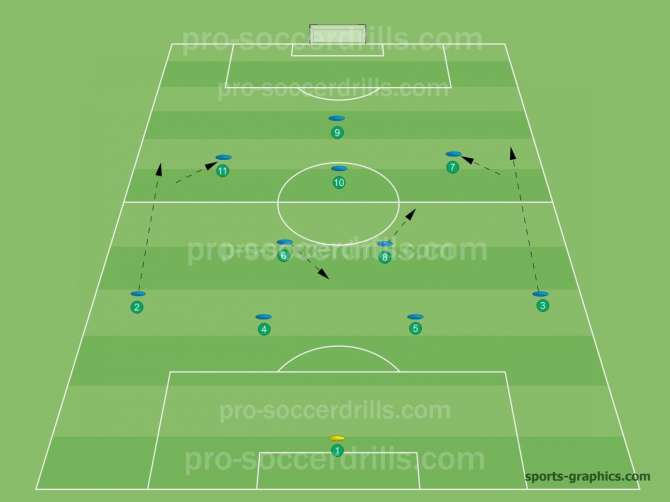
The "double pivot"
The two defensive midfielders are key for the 4-2-3-1 formation and has to be chosen well. Tactically they might be given two different tasks either in attack or defence. For instance one of them can be asked to stay behind and play near the opponent's central attacking midfielder (to prevent counter-attacks) and the other one can go and help the attack.
In the build-up play the two pivots can be constantly interchanging positions if needed.
The unmarked one can step back for the ball and the other one can prepare for a 2v1 in midfield.
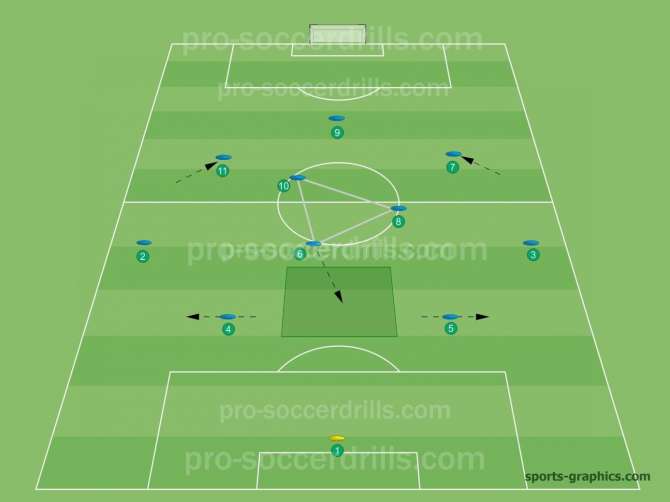
Both of the holding midfielders should read the game fast and accurately, they have to be able to intercept passes and cover each other. The work rate is not that high at this position but it depends on the attacking midfielder (10) player.
Coaches should choose holding midfielders who are intelligent in soccer and who can dictate the speed of play (mostly when changing the point of attack). At least one of these players should be the coach's right-hand man on the pitch. At least one of the two should be physically strong to master the midfield in defence.
The creative midfielders and the striker
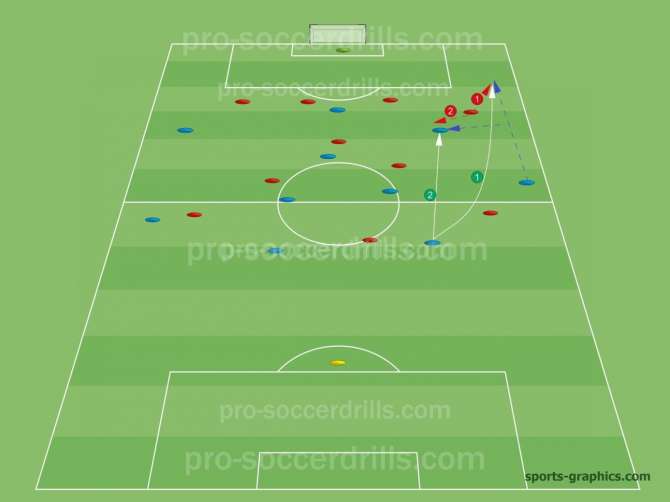
The 4-2-3-1 usually has 3 creative midfielders. These three have enough space to show their individual skills and also have a great cover behind them as there are at least 5 teammates covering their back. The full backs can overlap the wide midfielders so they have to help them open up space.
As the wingers should move towards the inside (dragging the opponent's full back), the left winger should be right-footed and the right winger should be left-footed. In case they get the ball when running towards the middle, the full back (teammate) is making an overlap so they force the opponent's full back to decide who to go with. Timing is key in this situation.
The central attacking midfielder should also be a creative player but his job is to get between the opponent's lines and ask for the ball.
This creativity can be improved using post-specific soccer games like this one: Functional Possession in 4-2-3-1
As soon as he is given the ball he should turn towards goal and either make a killer pass or finish individually by striking on goal. The best solution for a good body orientation is to always position himself diagonally to the ball's actual position. This also needs game intelligence.
The striker should be a real 9, not a false 9. He has enough players behind him and have enough space to move towards the flanks when needed. There are different type of strikers. One likes waiting in the middle for the ball dragging defenders and confusing them and others like moving towards the flanks helping teammates keep possession and arrive in the middle from far away to finish attacks with perfect timing. (e.g.: Lewandowski)
First Time in Full Length: Lewandowski's 9-Minute Miracle (youtube)
Coaches should choose great dribblers as wide midfielders and a good playmaker as a central attacking midfielder. The striker role and the individual tactic should depend on the personality of the attacker.
Pressing in the 4-2-3-1
There are principles of the pressing game that coaches can stick to so the first important step to do the pressing successfully is to find the appropriate area/position on the pitch that can be pressed effectively. This area is located on the flanks of the playing field where there are fewer opportunities for the opposition to play. 4-2-3-1 formation provides the width of the team so the first step should be to force the opposition towards the flanks. This player is mostly the full-back, so the central striker should not press but force the opponent to play towards the throw-line.
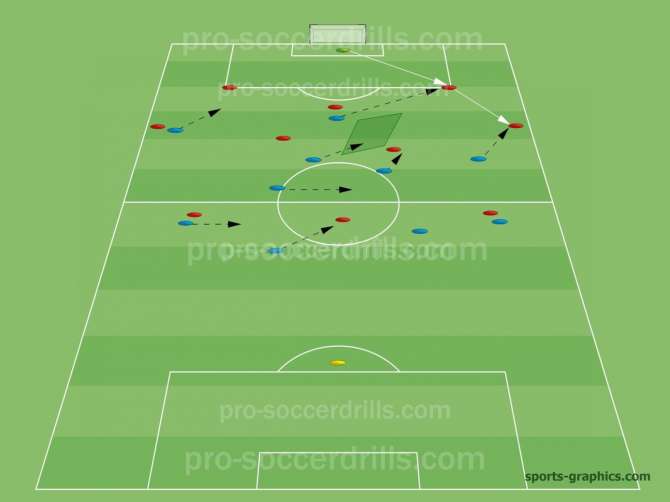
When the opponent has played the ball to the full-back, the defending team should lessen the space around the man on the ball. This pass made by the opponents can be the trigger to start the high-pressing game. There are different types of pressing (gegenpressing) but the defending team should always be moving towards the ball and cut every single possibilities for the opponent.
Depending on the opponent's style of play and formation, coaches should organise the pressing cleverly. The opponent should be forced to play a long ball that is risky for them or make an error and lose the ball. The whole team should move together to execute this effectively.
Compact defending in the 4-2-3-1
There are times when the defending team should drop back and this module of the game should also be organised. As the team plays with 2 defensive midfielders they can be given different roles in defence according to the ball's actual position and the opponent.
They are the key players to prevent the opponent's attackers to play a 1v1 or a 2v2 against the centre backs. The importance of the two pivots in defense can be seen in this video.
The lone striker should drop back behind the ball's line when the winger puts pressure on the man on the ball. The team's optimal length should be between 20-30 meters always. The only exception is when the opponent is trying to play a long ball in behind the defence because the defenders should always be ready for these so they have to backpedal to prevent goal-scoring chances.
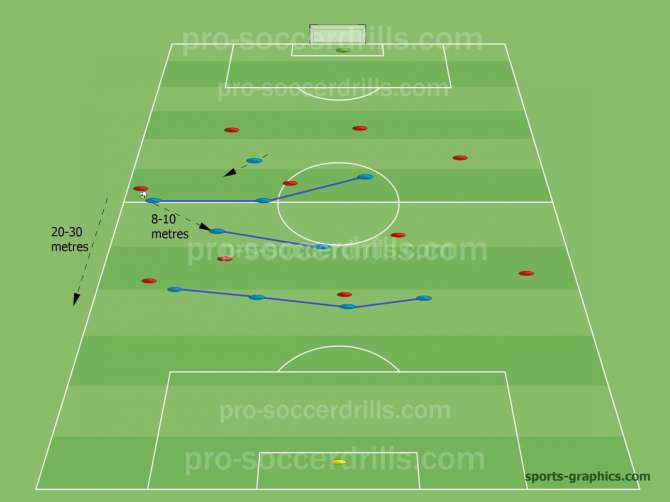
The optimal distance between the players should be around 8 to 10 meters and the players on the far side should move in until the halfway line of the pitch.
Counter-attacks in the 4-2-3-1
Counter-attacks are one of the most effective tools - soccer strategies nowadays to score goals. The opponent is unorganised, sometimes they open up and can't regroup in time, so the team on the ball has the chance to fill and exploit these areas. Most of the empty spaces are created on the flanks when counter-attacking so there need to be fast-paced wingers and they also need to be able to sprint more than 20 meters in their individual sprint zone that should be over 25 km/h at least.
The wingers must be played the ball by intelligent central midfielders so they have to pay attention to some principles. The most important principle when counter-attacking is that the player on the ball should be facing the opponent's goal. If a player is facing his own goal, he must turn or play the ball to a teammate. Playing the ball can speed up the process because the teammate facing the opponent's goal can see the spaces before receiving the ball.
The lone striker has an important task, too as he has to drag and occupy the central defenders to open up space on the flanks. He has to wait and move in the right moment if he wants to get the ball.
Advantages and disadvantages of the 4-2-3-1
Advantages
- Compact defensive organisation
- Fluidity in midfield
- Creative wingers
- Versatility
- Good cover for the centre backs
Disadvantages
- Less cover for full-backs
- Less occupation for the opponent's centre backs
Summary
4-2-3-1 is the beloved formation by many coaches these days. The two central pivots give the balance and the unpredictability for the team either in attack and in defence. They are key when the opponent has the ball as they have to cover the space and shield their central defenders.
Most coaches play with a box-to-box and an intelligent central pivot. One organises the play and the other makes deep runs into the box or shoots from distance.
Are there coaches who play this formation with his team? You can read about it more here.
Free Trial
GET YOUR FREE 14 - DAYS TRIAL NOW! INCLUDING:




